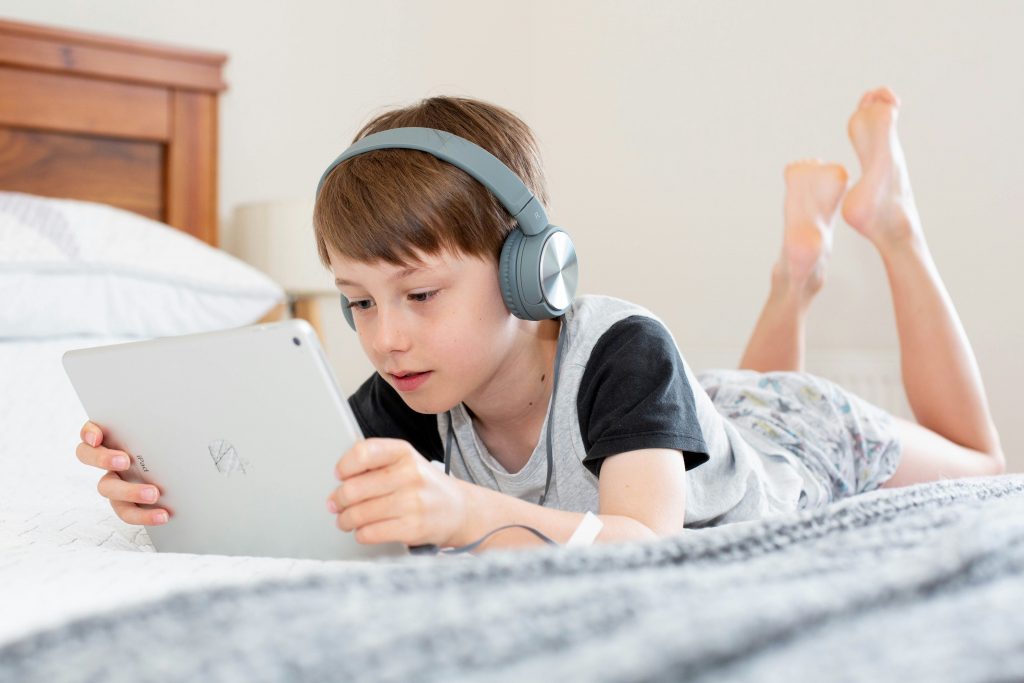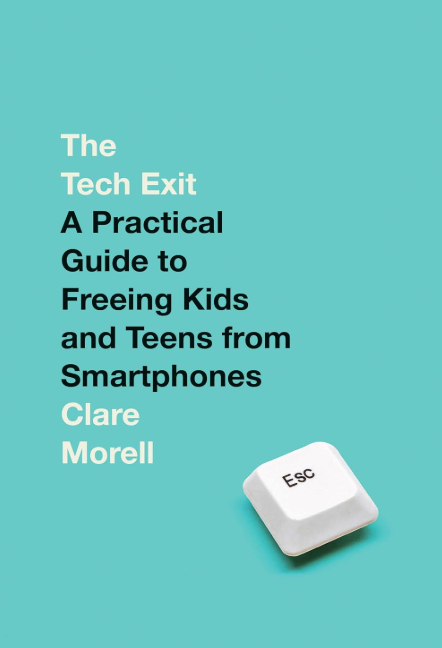Introduction to The Tech Exit: Why This Book Matters Now
If you’re a parent today, you’ve probably felt the uneasy tension around screens. Your child’s school encourages digital learning, their friends are glued to smartphones, and maybe you’ve already seen changes in their behavior — irritability after gaming, withdrawal without a device, or loss of interest in hobbies they once loved.
Clare Morell’s new book, The Tech Exit: A Practical Guide to Freeing Kids and Teens from Smartphones, tackles this head-on. Morell doesn’t tiptoe around the problem. She argues that moderation strategies — time limits, parental controls, “just a little bit of screen time” — are not enough. Screens are designed to addict, and children don’t yet have the maturity or self-regulation to resist them.
Her solution? A bold but practical roadmap to help parents free kids from digital dependency. This isn’t a call to throw your Wi-Fi router into the trash, but rather a conviction that protecting kids from addictive technologies is both possible and deeply rewarding.
How Screens Rewire Childhood
One of the most alarming sections of The Tech Exit highlights how screens don’t just consume time — they actually reshape children’s brains, habits, and desires.
- Loss of Imagination and Reflection: Morell points to research showing that constant digital stimulation erodes a child’s ability to sit quietly, think deeply, or use their imagination. When every free moment is filled with a screen, children stop developing the inner resources that come from boredom, creativity, and solitude.
- Stunted Social Growth: Instead of learning patience, empathy, and face-to-face interaction, kids become conditioned to expect rapid-fire responses and shallow connections. Over time, this leaves them less able to handle real-world social situations.
- Attention and Mood Disorders: Studies now link heavy screen use to rising levels of anxiety, depression, and attention disorders among teens. For example, the average American teen now spends over 8 hours a day on screens — more than a full-time job.
- Addiction by Design: Morell draws a sharp comparison: asking a child to use a smartphone “in moderation” is like asking them to “do drugs in moderation.” Devices and apps are engineered with persuasive technology that hijacks dopamine pathways.
- Misdiagnosis of Autism / ADHD: Doctor Victoria Dunckley sees parents bringing in their kids concerned they had ADHD or Autism due to their mood & behavioral issues. She found that in a lot of cases taking away their screens reduced the symptoms entirely or eliminated them all together.
Brain research really shows that even a small amount of time on social media, smartphones, any type of interactive screen, is highly addictive to the brain. It shows the brain actually goes into this dopamine deficit state as soon as the person gets off. And so, no time limit is ever enough because as soon as you leave an app or leave the screen, your brain does not return to a normal baseline. It actually dips below baseline to create this craving for you to repeat that behavior and do it again. And so, the brain imaging studies of heavy users of social media resemble the brains of those who have been addicted to highly addictive drugs. The structural changes happening at the brain level are the same.
Another convincing piece of research was a doctor named Victoria Dunckley who was seeing kids coming into her practice with mood issues: having trouble focusing, attention spans, a lot of behavioral issues, emotional dysregulation, mood swings, irritability, tantrums, etc. And she found that in a lot of cases just taking away the screens reduced the symptoms entirely … like eliminated them. Parents were coming in saying they thought their kid had ADHD or autism because of these behavioral changes they were seeing in their kids.
She found that these changes were actually induced by electronic screens. Doing a screen detox for 30 days eliminated the symptoms. In a lot of cases, the kid didn’t have autism or ADHD. It was a screen-induced response, even from 30 minutes of screentime a day. If it’s an interactive screen, like smartphones, social media, or video games, it puts the kids’ developing nervous system into this fight or flight mode.
The bottom line: screens aren’t neutral tools. They are carefully crafted to keep kids hooked, often at the expense of their mental, emotional, and spiritual health.
The “Tech Exit” Roadmap
In “The Tech Exit“, Morell offers more than just warnings. She lays out a concrete plan for parents, built around her FEAST framework:
- Find Other Families: Build community with like-minded parents who are also resisting the pressure to hand over smartphones.
- Explain, Educate, Exemplify: Talk openly with your kids about why your family is different, model the behavior yourself, and give them language to explain to peers.
- Adopt Alternatives: Help your kids discover sports, music, reading, volunteering, or other activities that give them purpose and joy.
- Set Up Digital Accountability: Establish clear rules, family tech policies, and guardrails where screens are necessary.
- Trade Screens for Real-Life Pursuits: Replace empty screen time with relationships, skills, and meaningful experiences.
This approach is not about punishment or deprivation. It’s about reorienting the family toward healthier rhythms and stronger bonds.
Do Screen Fasts Really Work?

Parents reading this might wonder: Isn’t it too late? What if my child already has a phone, already plays Roblox, already watches TikTok for hours?
Morell doesn’t shy away from this. She describes how families can successfully pull back, even after screens have been introduced. One tool is the digital fast — a week or more where devices are removed.
At first, there’s often pushback. Kids may be angry, anxious, or convinced they’ll be socially isolated. But over and over, families report a dramatic shift:
- Within days, children stop asking for their devices.
- They rediscover board games, outdoor play, or reading.
- Parents notice calmer moods, better sleep, and more conversation.
- Many children later admit they feel happier without screens.
“The Tech Exit” also notes that kids who resist smartphones through high school often carry that conviction into college. They don’t suddenly collapse without a device — many realize they never needed it in the first place.
This is one of the book’s most hopeful insights: children may complain at first, but deep down they know the screens are hurting them. They just need parents to provide an exit ramp.
Kids Know It’s Bad — But Don’t Have a Way Out
One of the most sobering takeaways is that many kids are aware of how screens make them feel. Teens admit to feeling lonelier after scrolling social media, frustrated after gaming binges, or exhausted from staying up late online.
But they don’t see a way out. Everyone else is online. Peer culture makes quitting feel impossible.
Here’s where parents come in: by creating a home where tech use isn’t assumed, and by finding other families who will stand with you, you give your child the freedom they secretly crave — the freedom to step back from the digital race.
Practical & Realistic Advice
A critique often aimed at screen-free advocates is that their advice feels unrealistic. What about schools that require certain apps? What about GPS when teens start driving?
Morell anticipates these questions. Her advice is both principled and practical:
- Yes, some apps may be required for assignments — but use them on a shared family computer, not a personal device.
- Yes, GPS is useful for new drivers — but get a basic phone with limited functionality, or a device that only runs navigation.
- Yes, life changes will demand flexibility — but don’t let that become an excuse for unlimited digital access.
This balance is what makes The Tech Exit stand out. It’s not about rejecting technology entirely; it’s about reclaiming control and refusing to hand over your child’s formative years to Big Tech.
Why Parents Should Read The Tech Exit
Parents today are bombarded with conflicting messages: some say technology is the future and kids need it early, others urge moderation, and still others quietly panic about the anxiety, depression, and isolation they’re already seeing.
Clare Morell cuts through the noise. She doesn’t deny that the digital world is here to stay, but she insists that childhood doesn’t need to be consumed by it. Her book offers:
- Urgency — a clear case for why waiting and hoping isn’t enough.
- Clarity — practical steps that any family can start applying today.
- Hope — testimony that families who reduce or eliminate screens often see immediate improvements.
Most importantly, The Tech Exit empowers parents to take leadership in an area where kids can’t — and won’t — set boundaries for themselves.
Closing Thoughts
If you’ve felt uneasy about screens in your home, this book will confirm your instincts and give you courage. If you’ve been overwhelmed and unsure where to start, it will give you a plan. And if you’ve already given up, believing it’s too late, it will remind you: it’s never too late to step back.
Morell’s message is clear: children are healthier, happier, and freer when they’re not tethered to smartphones. The road to digital freedom may feel countercultural, but it’s one of the most loving choices you can make as a parent.
👉 Strong recommendation: Every parent should read this book. It may change the way you see not just your child’s relationship with screens, but your own.
